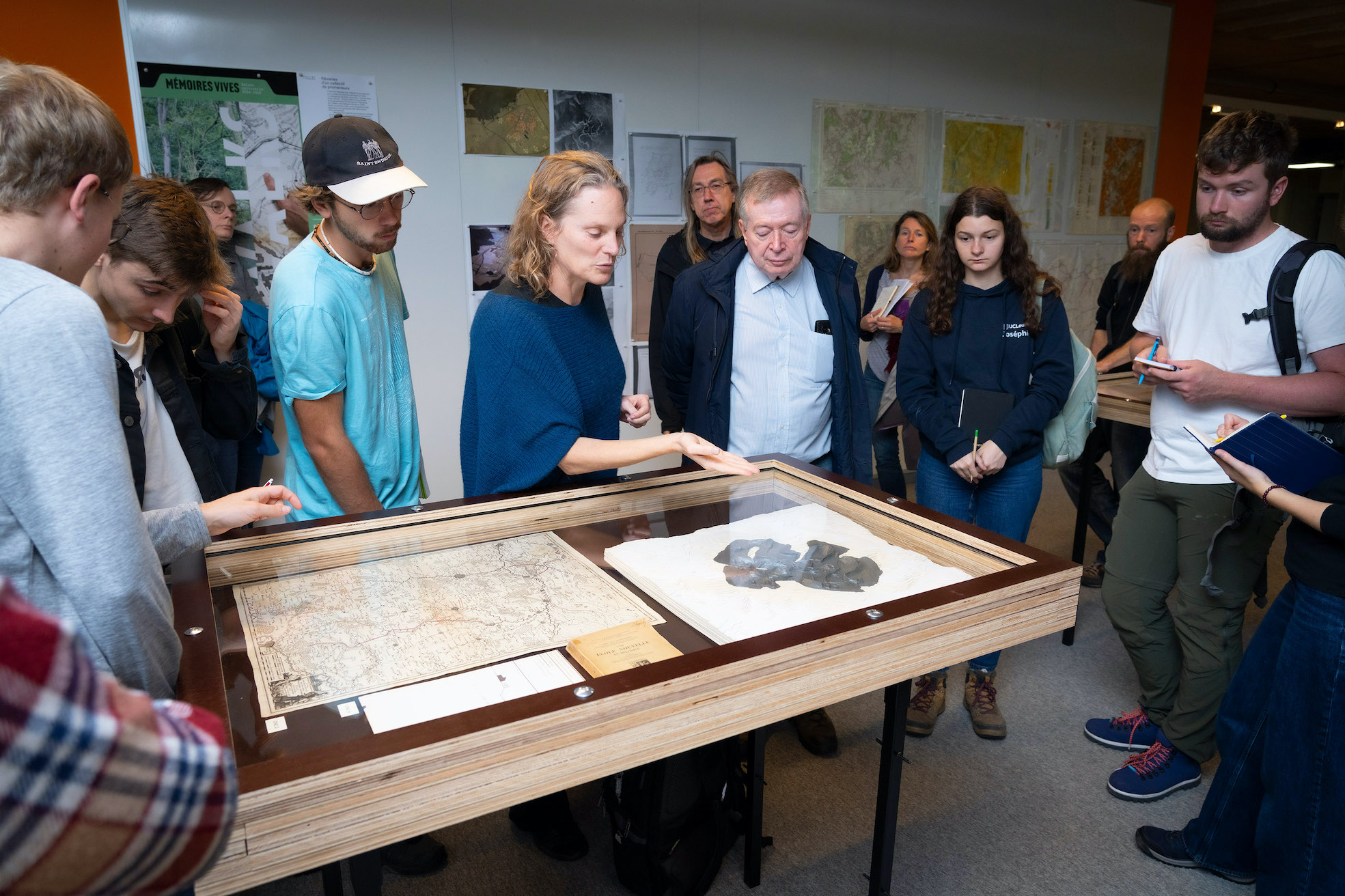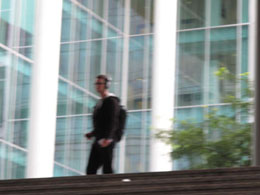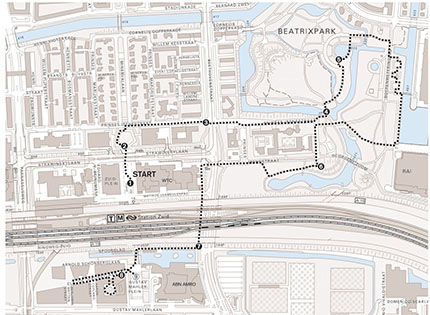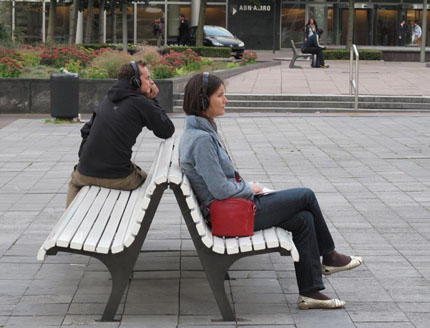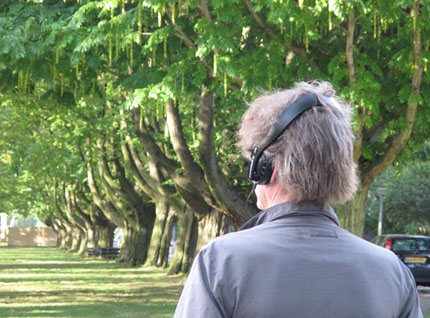7 Walks (Rêveries d’un collectif de promeneurs)
Pour la version francophone, cliquez ici
7 Walks (Rêveries d’un collectif de promeneurs) is a project by artist duo Vermeir & Heiremans in collaboration with Professor David Aubin (Political Science-UCLouvain) for the UCLouvain programme Fonds pour la Recherche-Création.
The project consisted of a documentary exhibition that allowed the artists to unravel the utopian thinking that had laid the foundations of the new city of Louvain-la-Neuve. Vermeir & Heiremans’ work in different archives has surfaced historical documents that reveal lesser-known narratives that can be re-read from the present. The artists ‘activated’ these documents at the start of five public walks in and around Louvain-la-Neuve, in the company of a number of invited guests.
Read the programme booklet here, with introduction, programme, credits and participants’ biographies
Read an interview with Vermeir & Heiremans here, published in Traces, the cultural newspaper of UCLouvain (in French)
Introduction
Rêveries d’un collectif de promeneurs is an artistic research project that initiates a dialogue on common goods – like water, land and art – and on the notion of their property relations and governance. As such it is part of our walking practice 7 Walks, which has been ongoing since 2019. In this new installment we will also be looking at cartography from an alternative pedagogical angle.
The project title references Jean-Jacques Rousseau’s (1712 – 1778) Les rêveries du promeneur solitaire, which is also the name of the walking path around the lake of Louvain-la-Neuve. The book offers a reflection on man and his relation with nature, thoughts Rousseau developed in ten walks. Rousseau’s thinking formed the basis for a new development in pedagogy grounded in the observation of everyday phenomena in their direct environment.
The debate on private property was highly influential among the Enlightenment philosophers of the 18th century. Rousseau saw property as the basis of corruption and inequality between people. For Voltaire (1694-1778) however a person without property could not be free. He saw property as the foundation of citizenship and of every social institution.
Rousseau’s ideas on education and property were much later picked up in the field of geography by Élisée Reclus (1830-1905), an anarchist geographer, who was teaching at the progressive Université Nouvelle in Brussels between 1894-1905. Reclus was very critical about the use of 2D-maps. He found they were not only deforming the representation of the earth but were also biased in favor of the powerful individuals or states that had commissioned them. In his Geographical Institute in Brussels he started developing curved reliefs and globes to be used in alternative schools. These tools represented the skin of the earth more truthfully.
But his favourite way to start his observations was through walking to the nearest stream, insisting that we learn ‘through the soles of our feet’, which he describes in his book Histoire d’un ruisseau (1869). In this book Reclus describes the use of the river as a resource and the need for a holistic approach: “In our civilised European countries where man intervenes everywhere to modify nature as he pleases, the small watercourse ceases to be free and becomes the property of its riparian owners.”
Walking together enables participants to be directly involved in a relational, place-determining and non-hierarchical exercise of perception. 7 Walks attaches great importance to this form of experimentation, immediately involving audiences in the process. Participants are invited to add their own stories and in that way become co-producers of ‘situated knowledge’ generated by the walks. Special guests are invited to nourish the discussions. Storytelling and discussing in public space fosters a shared value system and an increased appreciation of the public good.
Public spaces consisting of a sequence of public fora where people could easily meet, were part of the initial architectural designs for the new city of Louvain-la-Neuve – or LLN (1968). These public fora would be situated on concrete platforms that were planned to gracefully follow the undulation of the Malaise river valley. They were called the ‘communautaire’. They were totally devoid of cars, which were passing on a lower level underneath the layer of concrete.
The initial plans for LLN, based on ideals that were opposed to the abstract principles of modernism, were directly inspired by the work of Patrick Geddes (1854- 1932), a biologist, botanist and urban planner. Geddes based his valley section model on Elisée Reclus’ hydrographic basin model. Both were in favour of a holistic approach to urbanism, looking at physical, historical, political and social contexts that together would create the city as a living form, built from the bottom up, and with its roots firmly in space and time.
The work of Reclus and Geddes was influential for the English Garden Cities and later the New Towns, which were both also an inspiration for LLN’s planners. But would this go beyond the visual resemblance? Ebenezer Howard (1850-1928) who developed the Garden Cities, had quite novel views on property relations. In order to prevent land speculation he proposed to keep ownership of the land in a common trust. That way the increment in land value would be captured for and spent on the common good. Howard based his ideas on the work of the American economist Henry George (1839-1897) who claimed that the value of land is a social creation, rather than a private one.
The administration of UCLouvain chose a similar property form to develop the new city of Louvain-la-Neuve. (LLN is a newly built town which was born from the Leuven Crisis in 1968. This triggered a split of the University of Leuven along linguistic lines. It led to the creation of the KULeuven, the Dutch-speaking university, that would stay in Leuven, and the UCLouvain, which had to move to the future site of Louvain-la-Neuve, near Ottignies. Next to a campus the area would be developed as a new town that would host a diverse population. Construction started in 1969.) With a loan of the Belgian authorities UCLouvain acquired 9 square kilometers of farmland from the original owners. By law the land could not be sold for the next fifty years. It would be developed by handing out long-term leases of 99 years to individuals and developers who could build on the land. That way the university as ‘naked owner’ would remain in control of what would happen with the land, and in the same gesture prevent land speculation. At least that was the initial idea.
Programme of the walks
Walk#01 : PLURA DOMINIA
Wednesday 9 October 2-6 PM
Welcome by Ruth Kalf and Frédéric Brodkom at the BST – 1st floor
Introduction by Vermeir & Heiremans and David Aubin
Water cannot be separated from the landscape it has helped to create and which, in turn, shelters water. In 1969, the UCLouvain administration wondered how the construction of a new city and a university in the Malaise and Dyle valley would influence water management in the region. With David Aubin, we explored the notion of plura dominia. The concept introduces the simultaneous use of the same resource, in this case water, by different entities. Plura Dominia could outline a possibility of collective governance of the aquatic landscape, but it also demonstrates how important it is to take into account the structuring role played by policies in regulating the use of natural resources.
Walk#02 : CARTOGRAPHIE ET CONTRE-CARTOGRAPHIE
Saturday 12 October 2-6 PM
Guest: Gaspard Geerts
The documents, maps, drawings and reliefs selected for the exhibition will provide a critical look at maps and their development, particularly in relation to the plans for the new city of LLN and the various sources of inspiration from the 19th century. The focus on the work of urban planners and alternative education advocates Patrick Geddes, Élisée Reclus, and the garden cities of Ebenezer Howard, have created radically different maps and counter-maps of the city and very different relationships with the topography of the site. During the walk, we will explore the city in relation to its proposed and executed plans.
Walk#03 : À LA RECHERCHE DU BASSIN FLUVIAL
Thursday 17 October 2-6 PM
Guests: Veerle Vanacker, Sophie Vanwambeke
Following Reclus’s advice to start working from the nearest river, we had hoped to begin our research with La Malaise, an affluent of the Dyle, but it disappeared under the huge concrete slab of the city centre. With Veerle Vanacker and Sophie Vanwambeke, and their students from the Integrated Project in Geography course, we want to explore the reliefs and plans of LLN. We travel through the basins of the rivers La Malaise, Blanc-Ry and Dyle, drawing on Geddes’ valley section model and Reclus’s hydrographical basin model to explore the complex dynamics between physical geography, geology and human systems.
Walk#04 : TRACING UTOPIA
Saturday 19 October 2-6 PM
Guest: Vincent Pourcelle
The preparatory plans (1968) and the Plan Directeur (1970) both reflect the utopian visions of the designers for the city of LLN. One of the ideals was to make a city on a human scale, a pedestrian city without cars, where people could meet. With Vincent Pourcelle, nature and urban guide, we will find and test the viability of the utopian traces that still exist today. Vincent has been working for some time with Gaspard Geerts on a map project for La Baraque, an experimental district that resists expropriation by UCL for over 50 years. This map, which puts vegetation in the foreground, is the counterpart of LLN’s initial urban planning projects.
Walk#05 : RELATIONS DE PROPRIÉTÉ ET BIEN PUBLIC
Saturday 26 October 2-6 PM
Guests: Nicolas Bernard and Vincent Wattiez
LLN offers a unique case study in land governance. UCLouvain is the naked owner of the land. In the form of long-term leases of 99 years, and in exchange for a symbolic ground rent and an infrastructure fee, individuals or developers (who do not have to pay the price of the land) obtain the right to build on it. This form of ownership, quite exceptional in Belgium, separates the land from the buildings on it. This stratification of land ownership allows UCLouvain to retain control of the land, but could it also contain speculation?
We will address these questions with Nicolas Bernard who will share his expertise on the pros and cons of the long-term lease and his knowledge of alternative property relations.
We will also talk with Vincent Wattiez, a resident of La Baraque, who cooperated in the participatory process of developing a decree on light housing (habitat léger). Drawing on local and international housing initiatives, he is studying, with the RBDL, ways to challenge the relationship between property and speculation. Can alternative forms of housing and direct democracy applied to the alternative neighbourhood of La Baraque inspire other forms of property that would better protect the general interest and the social function of housing?
Collaborators and partners
For this project we enjoyed the privilege of working first and foremost with David Aubin, Professor of political science-UCLouvain, with Ruth Kalf bibliothécaire en cartothèque, and Frédéric Brodkom, director, both at the Bibliothèque des sciences et technologies
And with following archives and their collaborators:
Véronique Fillieux, Le Service des Archives de l’UCLouvain
Groupe des Archives de la Baraque, Archives de la Baraque
Flore Guiot, Réserve patrimoniale et précieuse des bibliothèques de l’UCLouvain
Irene Lund, Archives de la faculté d’architecture de l’ULB (“La Cambre architecture”)
Marlou de Bont, Hendrik Conscience Heritage Library, Antwerp
Benoît Van Calbergh, City archives of Ottignies-Louvain-la-Neuve
7 Walks (Rêveries d’un collectif de promeneurs) was produced by Jubilee, an artistic research platform and with the support of the Fonds pour la Recherche-Création of UCLouvain.
7 Walks (Placcaet)
Vermeir & Heiremans participate in the 2023 edition of Kunst & Zwalm, Over/with/within/through Water with a new chapter in their practice 7 Walks. Kunst & Zwalm is a biennial art route in the Zwalm region organised by BOEM vzw since 1997. The project invites artists to work closely with the environment and to imagine a new landscape. For this edition, Loes Jacobs/nadine and Chris Rotsaert/manoeuvre take on the joint curatorship. Together with 18 artists/collectives, they set to work around ‘water’. The reality of the Zwalm river crossing the landscape but also the power and mystics of water, and its social debate, became the guiding principle for unique artistic trajectories.
Vermeir & Heiremans present 7 Walks (Placcaet), a project that builds on the concept of ‘plura dominia’ or the simultaneous use of the same resource by different entities, in this case water. Next to a small documentary exhibition at the Zwalmmolen, they will perform four walks, in the company of four guest walkers, each with a different expertise related to water and its many uses and users.
Walking with…:
Sat 26/08/2023
David Aubin (UCL Louvain-la-Neuve – Politieke Wetenschappen) (EN)
Sun 03/09/2023
Lode Tanghe (Water+Land+Schap 2.0, Provincie Oost-Vlaanderen) (NL or EN)
Sat 09/09/2023
Tom Vos (Uantwerpen, Corporate governance) (NL or EN)
Sun 10/09/2023
Walter Van den Brande (conservator Mola, Zwalmmolen) (NL or EN)
Tracks
Tracks is a new app designed for audiowalks. Offering a growing collection of soundwalks and many functionalities, Tracks connects anyone with a smartphone to the work of sound artists to be discovered in the most immediate way. Tracks is released in 2023.
Download the app via Tracks’ project website
Tracks gives you the possibility of finding soundwalks close to you or using various keywords, downloading or streaming them, orientating yourself on the interactive map which also triggers the programmed soundtracks if the artist chooses to, leaving feedback to the creators and sharing with others.
Audiowalks are guided walks thoughtfully combined with the sensory attention of listening. They offer stories, music, sound experiments, and all kinds of sensory information you might otherwise miss. Sight, scent, and feeling are present, but sounds take the lead. This modulates one’s usual sense of body and consciousness, promoting a new understanding of the environment. With every step, hear the artist play with sound, experiment with composition, and lead you to new perceptions. Think of a film, where sound and image are strongly linked and controlled by the artist. In audiowalks, the ‘point of view’ becomes the ‘point of hearing’.
Tracks is a further development of Soundtrackcity, the app for audiowalks that Roeland Landegent first developed for Soundtrackcity in 2013. In the summer of 2020, Jubilee artist Justin Bennett initiated a collaboration with Soundtrackcity, leading to the idea of creating a new app that unites the audiowalks produced by art organisations in Belgium and Amsterdam: Jubilee, Beursschouwburg, BNA-BBOT, Overtoon, Q-O2, and Soundtrackcity. Together, they curate Tracks – an app for audiowalks.
Designed by Michiel Uilen
Developed with the kind support of Visit.Brussels
Vilgiskoddeoayvinyarvi: Wolf Lake on the Mountains
We follow Viktor Koslovsky, a scientist still working at the otherwise abandoned Kola Super-Deep Borehole, a geological research station “at the border of everything” in north-west Russia. He tells of the history of this former cold-war project and of his current research which he describes as “listening to the past in order to hear the future”.
The Kola Super-Deep Borehole (KSD) is the deepest man-made hole on earth – more than 12 km deep. It was a Soviet geology research project started during the Cold War. In addition to gathering data about the geology of the earth’s crust it formed part of Project Globus, a network of seismic listening stations which was to act as an early-warning system for natural disasters as well as for monitoring enemy nuclear tests. After the fall of the Soviet Union the project was slowly wound up and the site was abandoned in 2008.
The rock strata that are visible in the core samples extracted from the borehole are seemingly inert to humans but on another time-scale they are very much alive. They tell the story of the formation of the earth and of ultra-slow processes that are still taking place within the earth’s crust. Thinking at this geological timescale puts human endeavour and progress into perspective, the Kola Super Deep becomes merely a pin-prick into the body of the earth.
Still, the image of drilling so deep into the earth inflamed the imagination of evangelical Christians with an image of Hell. The sounds of screams emanating from the inferno circulated on the internet purporting to have been recorded by the Russian scientists – probably a montage of horror-film soundtracks. The layers of rock penetrated by the drill resound with Dante’s decent into the Inferno with Virgil as his guide – where each layer or circle of Hell is reserved for different kinds of sinners, each with their own story. In which circle of Hell can the conspiracy theorists be found? Which is reserved for the climate change deniers?
At the KSD site, next to Wolf Lake, we meet Viktor, a geologist who worked on the project until it was shut down. Ever since, Viktor has stayed on-site as much as possible, carrying on the work started by Dr. Huberman, the founder of the project. He recounts the history of the KSD, relating it to other cold-war science projects, about the geology and history of the area, and of his experiences living there alone. He guides us around the ruined site, introducing his living quarters, his small laboratory and of course the borehole itself. He explains his work, listening to vibrations deep within the earth, linking geology with Sami shamanism and divination.
The Vilgiskoddeoayvinyarvi: Wolf Lake on the Mountains project began during a residency of the art and research project Dark Ecology in Norway and Russia in 2015. In June 2016, during the third edition of Dark Ecology it was presented as a site-specific audio walk in Russian and English, where the audience visited the KSD site itself with my piece acting as an audio guide. The footage to be used in the final film, along with extra sound recordings, was shot during the final production process in Russia. The images were shot in HD with a DSLR. The audio techniques are diverse, including binaural and surround (ambisonic) recordings. A three channel audio visual installation of it was shown at the 2017 Sonic Acts festival in Amsterdam. In 2018, a new version of it was presented at Artefact 2018 in Leuven, with drawings, charts, and historical photographic material alongside the video images and sounds. A single screen film (25 min.) will be shown around the world.
Production: Justin Bennett and Jubilee
Commissioned by Dark Ecology and Sonic Acts
Supported by STUK and Mondrian Fund
Presentations to date:
Rencontres Internationales Paris/Berlin festival of moving image; Paris (2019)
Science of Sound, group exhibition at at Dordtyart, Dordrecht (2018)
Geological Imagination, duo exhibition with Cecilia Jonsson at Terminal B, Kirkenes (NO, 2018)
SOUNDS LIKE SILENCE, talk/ screening during the release party of O, Wonder! #2 at Compagnie Theater, Amsterdam (2018)
Artefact Festival 2018, This Rare Earth – Stories From Below, audiovisual installation at Artefact Festival in STUK, Leuven (2018)
SALT ART: Selected from Dark Ecology, Sauna Session and screening at SALT Árdna, Oslo (2018)
Inversia Festival, Murmansk (RU, 2018)
The Noise of Being, a group exhibition at Arti et Amicitiae for Sonic Acts Festival, Amsterdam (2017)
A like-named site-specific audio work, which preceded the film, was presented during Dark Ecology, the third edition of the art, research and commissioning project in the border zone between Norway and Russia (2016)
Telettrofono
An audio walk by Justin Bennett & Matthea Harvey
Stillspotting nyc is a two-year multidisciplinary project that takes the Guggenheim Museum’s programming out into the streets. Site-specific commissions in all five of New York City’s boroughs identify moments of urban quiet and stillness and respond to everyday issues of noise and anxiety. For stillspotting nyc: staten island, the fourth edition in the series , sound artist Justin Bennett and poet Matthea Harvey present Telettrofono, an audio walking tour that braids history with fantasy along and around the waterfront.
Antonio Meucci, a Staten Island resident of Italian birth, was the unacknowledged inventor of the first telephone (or telettrofono), conceived in 1849, when he accidentally discovered, while administering electrical shocks to a man suffering from rheumatism, that sound could travel along electrical wires. Many of his inventions – a marine telephone, a lactometer, flame-retardant paint and smokeless candles – went far beyond the imagination of his contemporaries.
For Telettrofono, Bennett and Harvey meld ambient sounds from the borough with invented noises, such as pianos of stone and glass, or a bone-xylophone, with a poetic script for an audio walking tour that weaves Meucci’s tragic true-to-life story together with fantastical elements. Bennett and Harvey envision Meucci’s wife, Esterre – a mermaid who leaves the water for land because of her love for the sounds above ground.
The walk in search of this storied couple meanders along the waterfront, past salt mounds and industrial sites, through historic residential neighborhoods and into places of discovery. The route is designed as a spiral to lead visitors out from the coast into the land, while the recorded story transports listeners out from the external urban environment into a state of introspection. Participants listen to the narrative soundscape through an imagined present-day telettrofono, a phone that is “smart” in the sense that it can enable listening under and across the water, dialing into fairytale and fact, mermaid choruses, and real and invented patent applications. The telettrofono guides the listener through changing perspectives on sound and place within the tale of the Meuccis from Florence and Havana, as well as the stories, sights, and silences distinct to Staten Island
A visit to Telettrofono consists of a self-guided soundwalk where participants engage in a walking tour around Staten Island, guided by the pre-recorded sounds transmitted through borrowed iPods. Visitors begin at a stillspotting kiosk located at the Staten Island Ferry Terminal in St.George.
Stillspotting nyc is organised by David van der Leer, Assistant Curator, Architecture and Urban Studies, with Sarah Malaika, Stillspotting Project Associate, Solomon R. Guggenheim Museum.
Spectral Analysis
Justin Bennett
Spectral Analysis is concerned with the history of the use of technology as a tool for exploring and revealing the invisible. The invisible or spectral domain can be thought of as the electro-magnetic spectrum outside of our vision, but also the unconscious or even the afterlife. ‘Acousmatic’ audible presences without an obvious visible source can also be thought of as belonging to this domain.
The background of this project is research into:
– Medical history: mesmerism, electro-therapy, phrenology, hypnotism, psychoanalysis, experimental and anti- psychiatry, psychoacoustics, music therapy.
– Occult history (spiritualism, theosophy, conspiracy theory) and its relation to modernist art and radical social movements.
– The role of technology in these histories, particularly at the turn of the 20th century and the transformation of these technologies with the coming of the digital age.
The role of the artist: the artist as experimenter, as inventor, as medium, as patient.
Up to now, the boundaries of this work have been explored in two sound walks (headphone-based audio-guides) and a series of drawings.
Spectral Analysis Krems – a series of “audio experiments” focussing on the relationship of electromagnetic radiation and sound. (produced by Kontraste Festival, Austria)
Spectral Analysis WG – we listen to the recorded notes of a psychiatrist as he accompanies a patient around the grounds of a hospital. Gradually he and the listener get drawn in to the experiments that the patient conducts with his self-made devices. (NASA, Amsterdam, produced by Sonic Acts, Amsterdam.)
Zuidas Symphony
An audio walk by Justin Bennett
Zuidas Symphony is a audio tour around the business district of Amsterdam and its surroundings, particularly the Beatrixpark, which has been the subject of many struggles over land use.
Listening to the surroundings themselves is the starting point of this work. Not just because the experience of the urban soundscape can be an aesthetic experience, but also because listening intently to the city encourages a radically different way of ‘seeing’ it.
What is the sound of the Zuidas? How does the soundscape change as the buildings rise and the environment changes daily. What is the relationship of city planners to sound and noise? Are the ‘open’ spaces of the Zuidas actually public? Can sound create public spaces?
These questions and more are explored through interviews, field recordings, pirate radio broadcasts and resident’s protests.
Zuidas Symphony was produced by Soundtrackcities and Virtueel Museum Zuidas
